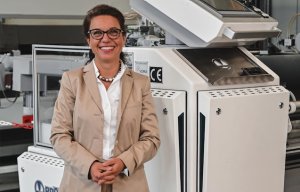
Textile machinery for a sustainable textiles industry
“We must work together if we want to develop affordable manufacturing automation solutions along the entire process chain to help bring about the required reduction in the cost of the finished product,” VDMA Composite Technology Forum spokesman and KraussMaffei Technologies GmbH board member Frank Peters told Monday’s Series manufacture of composites – across-the-board automation meeting in Frankfurt.

17th May 2012
Innovation in Textiles
|
Frankfurt
 “We must work together if we want to develop affordable manufacturing automation solutions along the entire process chain to help bring about the required reduction in the cost of the finished product,” VDMA Composite Technology Forum spokesman and KraussMaffei Technologies GmbH board member Frank Peters told Monday’s Series manufacture of composites – across-the-board automation meeting in Frankfurt.
“We must work together if we want to develop affordable manufacturing automation solutions along the entire process chain to help bring about the required reduction in the cost of the finished product,” VDMA Composite Technology Forum spokesman and KraussMaffei Technologies GmbH board member Frank Peters told Monday’s Series manufacture of composites – across-the-board automation meeting in Frankfurt.
This was the first time that members of the VDMA Composite Technology Forum and of the partner organisations AVK, Carbon Composites e.V. and CFK Valley Stade e.V. had got together to exchange ideas.
In his welcoming address to industry representatives and scientists, Frank Peters highlighted the importance of close cooperation between machinery and plant manufacturers and the industries using fibre composites as well as among their various networks.
More than 150 delegates discussed approaches to automation and what was required of plant and machinery manufacturers, stressing the benefits of knowledge transfer for the necessary joint developments.
In his keynote address on the challenges of automation, Klaus Drechsler, Professor of Carbon Composites at Munich Technical University, identified carbon fibre-reinforced plastics (CRP) as having the greatest potential of all material systems in lightweight construction, with a possible 90 per cent saving in process costs.
“Use of carbon fibre- reinforced plastics in industrial-scale production does however still require considerable research efforts, from the material sciences through structural mechanics to process engineering. Automation solutions from machinery and plant manufacturers are the key drivers for industrialisation,” Mr Drechsler said.
Largely manual production currently predominates in all sectors. The aviation industry and motor racing normally only require small runs of CRP components, albeit with high quality requirements.
Professor Axel S. Herrmann of Airbus Operations added:
“The use of high-quality, high-performance fibre composites is now well-established in the aviation industry. The experiences made with small batch and large component manufacturing can also be transferred to other industries.”
“There are considerable synergies with the motor industry, as aircraft parts, e.g. for the next generations of single aisle aircraft, have to be made in similarly large quantities. Highly automated manufacturing processes will have to be developed to satisfy cost and quality requirements. To achieve this, we need an extensive transfer of knowledge among all networks across the globe.”
Composite component manufacturing will have to be overhauled completely if large-scale production is to be introduced in the motor industry, for example, explained Heinrich Timm of AUDI AG.
“Lightweight construction goes far beyond reducing consumption and emissions. Lightweight construction is also about the sustainable saving of resources and driving safety. That is why the focus is on lightweight more than ever before, inspiring ideas in composite construction ranging from steel and aluminium to fibre-reinforced materials. The best material for the purpose, in the smallest possible quantity and in the right place: that is the way to economic lightweight construction.”
“This means developing and automating the manufacturing and joining processes for the production line. The VDMA’s current practice of exchanges between machinery and plant manufacturers and user industries is of the utmost importance here.”
According to the VDMA, lightweight components are increasingly being used for the new generations of motor vehicles in particular, especially to compensate for the weight of electric vehicle batteries and to cut fleet consumption overall.
In terms of quantity, glass fibre-reinforced plastics (GRP) will continue to dominate the composites market for a long time to come. However, with increasing rotor diameters the important wind turbine sector is more and more combining glass fibre-reinforced plastics with carbon fibre-reinforced plastics to make improvements. Suitably trained workers to implement this in all fields of application are in short supply, Dr. Rolf Bütje of Nordex told the meeting.
“As a result of expanding rotor diameters, the performance requirements of wind turbines, both on- and offshore, continue to rise. New construction methods, materials and designs can reduce the weight of the rotor blades and increase their stability. Simulation tools and automatically pre-set product qualities are important in helping German suppliers retain their status as market leaders. It requires know-how from the entire composites industry, as gathered here today,” Mr Bütje said.
The use of fibre composites in series production requires reliable processes with short cycle times and a high degree of accuracy; at the same time, prices of high-performance fibres will have to come down in order to be competitive, the VDMA says. The challenges of automated manufacture arise at every stage: textile moulded part manufacture, cutting, handling of limp fabricated materials, injection and hardening processes, tool design, joining and assembly techniques, working and testing of components, the organisation concluded.
For all these questions, the Composite Technology Forum brings together more than 130 VDMA member firms from eight associations to pursue the necessary developments jointly with the customer industries. With thermo process technology, textile machinery, garment and leather technology, plastics and rubber machinery, robotics and automation, machine tools, precision tools and testing machines, the entire process chain is covered, from fibre to finished component. As the institutional patron of the Composites Europe trade fair, the Forum and its member firms will be showcasing these skills in Düsseldorf from 9 to 11 October 2012.
According to the VDMA, the German firms of the composites industry, whether producers or users, will however only remain world leaders if they take the road to series production together.
Explaining how all industries needed to stand shoulder to shoulder, Frank Peters summed up in Frankfurt by saying: “The use of fibre composites in the series manufacturing of user industries requires a level of automation not so far achieved. With the VDMA Composite Technology Forum, plant and machinery manufacturers are making common cause to develop solutions together with the AVK, Carbon Composites and CFK Valley Stade networks. The partners’ workshop has been warmly welcomed and is an important milestone. With its excellent research establishments and world leading industries, Germany offers the best conditions for a leading market position in composites manufacture.”
VDMA Composite Technology Forum, Lyoner Str. 18, D-60528 Frankfurt/Main
Thorsten Kühmann, Tel. + 49 69 6603 1831, [email protected]
Thomas Waldmann, Tel. + 49 69 6603 1271, [email protected]

Business intelligence for the fibre, textiles and apparel industries: technologies, innovations, markets, investments, trade policy, sourcing, strategy...
Find out more